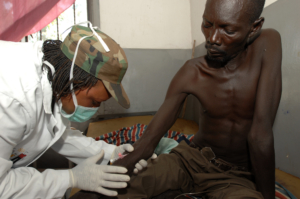CRISPR Gene Editing To Treat Sickle Cell Disease
 CRISPR gene-editing technology is now being used to treat various illnesses. This holds the potential to be a life-changing development for many people and may treat those plagued with sickle cell disease around the world.
CRISPR gene-editing technology is now being used to treat various illnesses. This holds the potential to be a life-changing development for many people and may treat those plagued with sickle cell disease around the world.
What is Sickle Cell Disease?
Sickle cell disease is most prevalent in African countries, where having one copy of the sickle cell gene helps protect people against malaria. However, having two copies of this gene results in sickle cell disease. Sickle cell disease occurs because of a genetic mutation that causes red blood cells to develop a sickle-shape and this obstructs healthy blood flow. The condition can cause serious pain and negative health effects, usually resulting in early death. When considering children with the disease, 70% are born in sub-Saharan Africa. Unfortunately, these countries do not have adequate resources to properly alleviate the symptoms of this condition, let alone treat them.
A Potential Cure
In recent months, it has been discovered that CRISPR gene-editing technology may be the key to curing sickle cell disease. CRISPR–Cas9 is a naturally occurring defense system that edits DNA sequences to fight viruses in the human body. In the past decade, scientists have discovered how to harness this system’s ability to manipulate DNA in chosen ways. The result of this is CRISPR gene editing is a powerful technology that can correct genome defects and even alter entire genomes.
CRISPR technology works by editing genes, which modifies how the body functions. First, medical professionals remove patients’ bone marrow and treat it. Then, CRISPR allows scientists to “cut and paste” bits of the genome by either cutting or adding a sequence of DNA into the genome. This can correct genetic mutations, ultimately improving a patient’s health.
In the U.S., a trial of using CRISPR to cure sickle cell disease is yielding promising results. The treatment uses CRISPR technology to activate a gene that instructs the body to produce fetal hemoglobin instead of adult hemoglobin. The presence of fetal hemoglobin prevents the blood cells from sickling. In this way, the treatment alleviates the health complications typically resulting from sickle cell disease. The subject of this trial is much healthier and has made exceptional progress in her recovery. These spectacular results have left many people hopeful that CRISPR technology could successfully treat sickle cell disease, with more widespread results by 2022.
The Future of CRISPR Treatment
For CRISPR treatment to reach its full potential, it must become more accessible to those who need it most. Therefore, the underprivileged in sub-Saharan Africa would benefit greatly. One suggested way to overcome accessibility barriers is through a tiered-pricing system. This system would offer gene therapy treatment to patients in developing countries at a reduced price, while patients in high-income countries would be expected to pay for the treatment in full.
There are currently logistical barriers to this solution, as gene therapy can cost thousands of dollars. The cost of CRISPR treatment would have to be greatly reduced (beyond the normal price drops of tiered pricing) to be successfully made available to the underprivileged. Additionally, this treatment requires consistent doctor visits. Much of sub-Saharan Africa lacks access to health clinics and other essential resources, such as refrigeration.
Breaking Down Barriers
Organizations are helping to eliminate the barriers blocking CRISPR treatment for sickle cell disease in developing countries. The National Institutes of Health and the Bill and Melinda Gates Foundation donated $200 million to this cause in 2019. This money will help make gene therapy accessible throughout the world and improve the quality of life for thousands. With the promise of affordable CRISPR gene modification therapy, there is hope for individuals worldwide to treat sickle cell disease. Permanently improving the quality of life is the end goal. Those living in developing countries, the global poor and those vulnerable to falling into poverty will be the most to benefit from this exciting, technological development.
– Hannah Allbery
Photo: Flickr
